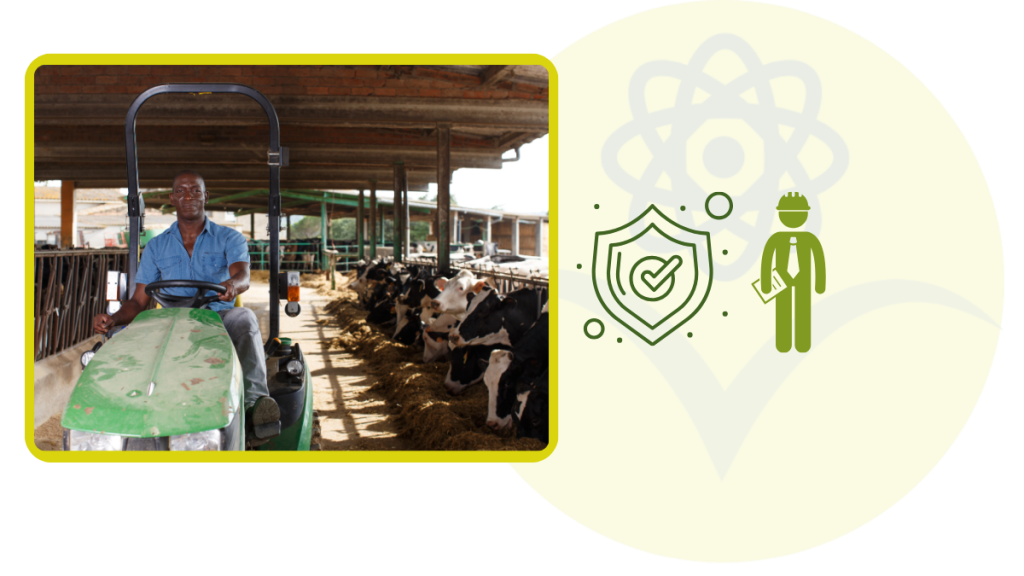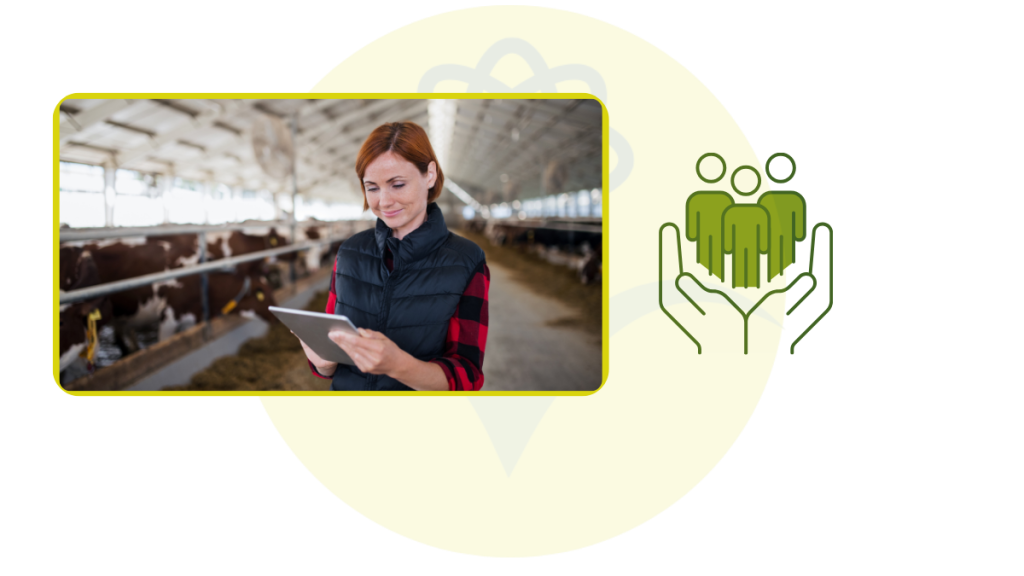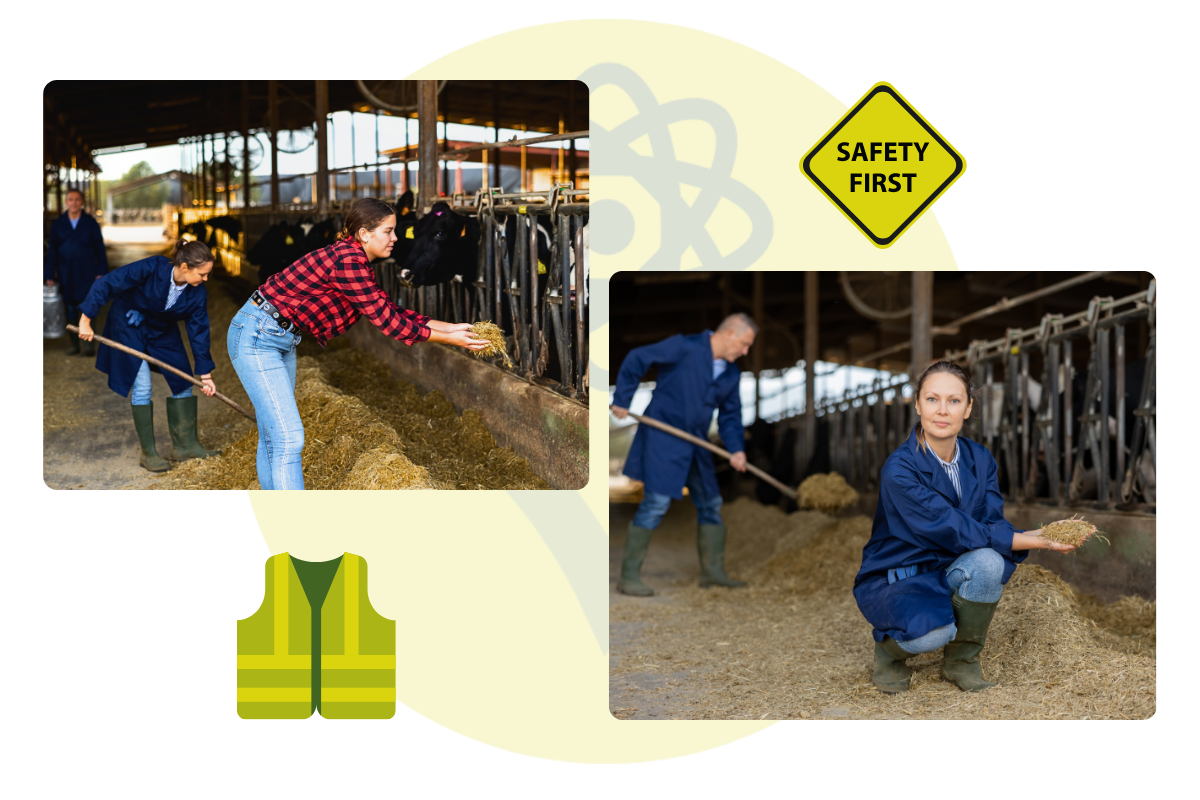The dairy farm environment can also pose significant safety risks, Dairy farm worker safety is the priority for the hardworking individuals who keep these operations running.
From handling heavy machinery to working with large animals, dairy farm workers face a unique set of hazards that require diligent safety practices.
Dairy farm worker safety guidelines
In this comprehensive blog post, we’ll explore the essential safety guidelines that every dairy farm worker should know and follow to protect themselves and their colleagues.
By understanding the common dangers and implementing proven safety measures, dairy farm workers can help create a culture of safety that benefits the entire operation.
Let’s dive in and ensure the well-being of those who play such a crucial role in bringing dairy products to our tables.
Understanding the Dairy Farm Hazards
Dairy farming is a vital industry that provides us with a wide range of dairy products we rely on every day.
Dairy farms are dynamic workplaces that present a wide range of potential safety risks.
Recognizing these hazards is the first step in developing effective safety protocols. Some of the most common dangers faced by dairy farm workers include:
Machinery and Equipment Hazards
Dairy farms rely on a variety of heavy machinery and equipment, such as tractors, feed mixers, milking machines, and manure-handling systems.
The improper use or maintenance of this equipment can lead to serious injuries, including crushing, entanglement, and amputations.
Animal Handling Risks
Cows, bulls, and other livestock on a dairy farm can be unpredictable and potentially dangerous.
Workers may be kicked, trampled, or even attacked by these large animals, especially during tasks like milking, breeding, or veterinary procedures.
Environmental Hazards
Dairy farms often involve exposure to extreme weather conditions, uneven terrain, and hazardous substances like chemicals, manure, and dust.
These environmental factors can contribute to slips, falls, respiratory issues, and other safety concerns.

Ergonomic Challenges
Many dairy farm tasks, such as milking, feeding, and cleaning, involve repetitive motions and heavy lifting.
These physical demands can lead to musculoskeletal disorders, back injuries, and other ergonomic-related problems.
Zoonotic Diseases
Dairy farm workers may be at risk of contracting zoonotic diseases, which are illnesses that can be transmitted from animals to humans.
Examples include brucellosis, salmonellosis, and leptospirosis.
Understanding these potential hazards is crucial for dairy farm workers to take the necessary precautions and implement effective safety measures.
Establishing a Culture of Safety
Creating a strong culture of safety on a dairy farm is essential for protecting workers and promoting a positive work environment.
This starts with the commitment and leadership of the farm owners and managers, who must prioritize safety and make it an integral part of the organization’s values and practices.
Safety Training and Education
Comprehensive safety training is a cornerstone of a successful dairy farm safety program.
All workers, from new hires to experienced veterans, should receive thorough training on the proper use of equipment, safe animal handling techniques, and emergency response procedures.
This training should be ongoing, with regular refresher courses and updates to keep workers informed of the latest safety protocols and industry best practices.
Encouraging open communication and feedback from workers can also help identify areas for improvement and ensure that the safety program remains effective.
Proper Personal Protective Equipment (PPE)
Providing and requiring the use of appropriate personal protective equipment (PPE) is a critical component of dairy farm safety.
This includes items such as:
- Sturdy work boots with slip-resistant soles
- Gloves for handling animals and equipment
- Protective eyewear to shield against dust, debris, and chemical splashes
- Respirators or dust masks to filter out airborne contaminants
- High-visibility clothing for working in low-light conditions or near heavy machinery

Ensuring that workers have access to and consistently use the necessary PPE can significantly reduce the risk of injuries and illnesses on the dairy farm.
Comprehensive Safety Policies and Procedures
Dairy farm operators should develop and implement comprehensive safety policies and procedures that address the specific hazards and risks present in their operations.
These policies should cover a wide range of topics, including:
- Machinery and equipment operation and maintenance
- Animal handling and restraint protocols
- Hazardous materials storage and handling
- Ergonomic best practices for physically demanding tasks
- Emergency response plans and evacuation procedures
- Accident reporting and investigation processes
By establishing clear, well-documented safety policies and procedures, dairy farms can create a framework for consistent safety practices and empower workers to take an active role in maintaining a safe work environment.
Safety Audits and Continuous Improvement
Regular safety audits and inspections are essential for identifying and addressing potential hazards on the dairy farm.
These assessments should be conducted by qualified safety professionals or designated safety committee members, and the findings should be used to continuously improve the farm’s safety program.
Dairy farm operators should also encourage workers to report any safety concerns or near-miss incidents, as this feedback can help identify areas for improvement and inform the development of more effective safety measures.
By fostering a culture of safety, dairy farms can demonstrate their commitment to the well-being of their workers and create an environment where everyone feels empowered to prioritize safety in their daily tasks.
Implementing Safety Protocols
With a strong foundation of safety awareness and a commitment to creating a safe work environment, dairy farm operators can focus on implementing specific safety protocols and best practices.
These protocols should address the unique hazards and risks present in the dairy farm setting.
Machinery and Equipment Safety
Ensuring the safe operation and maintenance of dairy farm machinery and equipment is crucial for preventing serious injuries. This includes:
- Providing comprehensive training on the proper use and operation of all equipment
- Implementing lock-out/tag-out procedures for servicing and repairing machinery
- Regularly inspecting and maintaining equipment according to manufacturer recommendations
- Ensuring that all guards, shields, and safety devices are in place and functioning correctly
- Establishing clear procedures for reporting and addressing any equipment malfunctions or safety concerns
By prioritizing machinery and equipment safety, dairy farm operators can mitigate the risk of accidents and protect their workers.
Animal Handling Best Practices
Safely handling dairy cows, bulls, and other livestock is a critical aspect of dairy farm safety.
Workers should be trained in the following animal handling techniques:
- Approaching animals calmly and quietly to avoid startling them
- Using proper restraint methods, such as headlocks or chutes, when necessary
- Maintaining a safe distance from animals and avoiding direct contact when possible
- Recognizing and responding appropriately to signs of aggression or unpredictable behavior
- Implementing procedures for safely moving and transporting animals
Additionally, dairy farms should ensure that their facilities, such as barns, pens, and walkways, are designed with animal safety in mind, promoting a low-stress environment for both workers and livestock.

Environmental Hazard Control
Addressing the environmental hazards present on a dairy farm is essential for protecting worker health and safety. This includes:
- Implementing effective ventilation systems to reduce exposure to dust, gases, and other airborne contaminants
- Providing adequate lighting and ensuring that walkways and work areas are free of obstacles and slip/trip hazards
- Properly storing and handling hazardous chemicals, such as cleaning agents and pesticides, in accordance with safety guidelines
- Implementing effective manure management systems to minimize exposure to pathogens and reduce the risk of zoonotic diseases
By controlling these environmental factors, dairy farm operators can create a safer and healthier work environment for their employees.
Ergonomic Considerations
Dairy farm tasks often involve repetitive motions, heavy lifting, and other physically demanding activities that can lead to musculoskeletal disorders.
To address these ergonomic challenges, dairy farm operators should:
- Provide training on proper lifting techniques and safe work practices
- Implement mechanical aids, such as hoists or carts, to reduce the physical demands of tasks
- Rotate workers between different tasks to minimize the impact of repetitive motions
- Encourage regular breaks and stretching exercises to help workers maintain their physical well-being
By addressing ergonomic factors, dairy farm operators can help prevent injuries and promote the long-term health and productivity of their workforce.
Emergency Preparedness and Response
Dairy farms should have comprehensive emergency preparedness and response plans in place to ensure the safety of workers in the event of an accident or other crisis.
This includes:
- Developing detailed emergency action plans that outline the steps to be taken in various emergency scenarios
- Providing accessible first aid kits and ensuring that workers are trained in basic first aid and CPR
- Establishing clear communication protocols and designating emergency response coordinators
- Regularly conducting emergency drills and training exercises to ensure that workers are prepared to respond effectively
By being proactive and well-prepared for emergencies, dairy farm operators can minimize the impact of accidents and protect the well-being of their workers.
Conclusion
Maintaining a safe and healthy work environment is a critical responsibility for dairy farm operators.
By understanding the unique hazards present in the dairy farm setting, establishing a strong culture of safety, and implementing comprehensive safety protocols, dairy farm workers can help protect themselves and their colleagues from harm.
Through ongoing training, the use of appropriate personal protective equipment, and the continuous improvement of safety practices, dairy farms can create a work environment where safety is a top priority.
By prioritizing worker well-being, dairy farm operators can not only protect their employees but also contribute to the overall sustainability and success of their operations.
Remember, a safe dairy farm is a productive dairy farm.
By embracing these essential safety guidelines, dairy farm workers can play a vital role in ensuring the continued success of this vital industry.
Here is how to craft a successful dairy farming Business Plan for sustainable growth.
Learn more about dairy farm safety and cattle handling.

